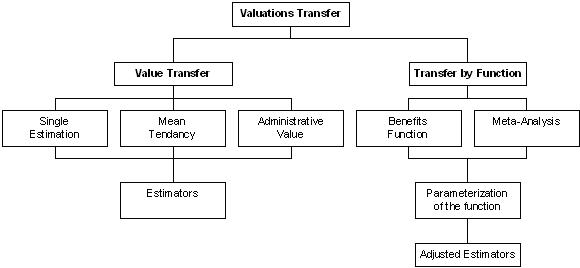Value Transfer
From Coastal Wiki

|
References need to be linked/embedded into the text
Studies evaluating the value of non market goods and services provided by natural resources are time and money consuming. The article provides insight in methods for transfer of results from existing studies to new sites and situations.
Contents
Introduction
- Coastal areas provides public goods and services, which generates difficulties for their management and evaluation. In order to set up prices for the supplied services, circuitous or indirect methods have been successively developed to elicit people's preferences: one distinguishes revealed and stated preferences.
- Depending on the context and the kind of value needed, all these methods are currently used. Contingent valuation method (CVM) is the most employed one because of its polyvalence, and because it implies non-use values, but the results are very context-related. In practice, these techniques require expensive logistics in terms of time and money.
- Facing the constraints and costs of these methods when they must be developed for each case, another way to proceed is open. The solution often applied to face these problems of costs is to try to transfer existing results determined on "study sites", at one moment and in a given context, to other sites, called "policy sites", when their characteristics are quite close. This is the principle of the benefits or valuations transfer.
- This method is pragmatic and, in any way, cheaper for the economic valuation of many environmental goods. Indeed, when it is possible, it gives the opportunity to estimate benefits, whereas a complete study to determine the value of non-tradable assets would not be feasible by lack of time or financial resources.
The different ways to perform a Value Transfer
- The following figure indicates the different methods that can be used to perform a valuations transfer.
- At first, the type of transfer must be fixed. The simplest way is to transfer a value or a set of values from one site (or average values of a group) to another, simply taking into account the purchasing power parity (space correction) and the inflation (time correction) if the original values come from a different country and/or a different year. However, if such an approach gives the possibility to get immediate values, it raises some questions about the credibility of such a valuation and implies qualifications: the environmental context and the activities tend to differ between the different sites.
- To take into account these specificities, it is possible, in some cases, to transfer not values, but an economic function estimated on the results obtained for one or a group of sites, in a sort of meta-analysis. For example, the value of water can be explained as a function of specific variables linked to the site (physical characteristics, activities, etc.) and on the resident population (socio-economic variables, sensitivity to the environment, etc.). Many authors have showed that this method gives more reliable results because the transferred equation is parameterized according to the characteristics of the "policy site".
- To face the increasing demand for "good" primary studies, many dedicated Internet sites are being developed like EVRI in Canada or the Damage Database of the International Office for Water in France.
Validity of the method
- Among the strengths of the valuations transfer method, one can easily notice that few surveys are enough to provide relevant economic values. This generates savings of time and money.
- However, the transfer is not always possible if this function includes contextual variables that are difficult to find or even compute on the policy site, e.g. water quality is very sensitive to the phenomenon of eutrophication. Moreover, it is necessary to select the transferable studies before performing the application in itself. A "bad" original study will gender a "bad" transfer and the reciprocal one is not always true.
- Performances are debatable: Considering "error transfer rates", i.e. the weighted difference between original and transfered values, it is equal to about 50% for the best studies. Of course, transfers by function or meta-analysis provide more reliable results.
References
- Brander L.M., Florax J.G.M. and Vermaat J.E. (2006), The empirics of wetland valuation: A comprehensive summary and meta-analysis of the literature, Environmental and Resource Economics, 33(2) 223-250.
- Brouwer R., Langford I.H., Bateman I.J. and Turner R.K. (1999), A Meta-Analysis of Wetland Contingent Valuation Studies, Regional Environmental Change, 1(1) 47-57.
- Woodward R. T. and Yong-Suhk W. (2001), The economic value of wetland. services: a meta-analysis, Ecological Economics, 37 257-270.
Related articles
- Travel cost method
- Contingent Valuation Method
- Hedonic Evaluation Approach
- Economic Value
- Total Economic Value
- Socio-economic evaluation
- Non-use value: bequest value and existence value
- Values of amenities in coastal zones
- Multifunctionality and Valuation in coastal zones: concepts, approaches, tools and case studies
- Multifunctionality and Valuation in coastal zones: introduction
Please note that others may also have edited the contents of this article.
|
